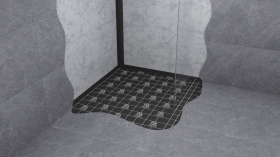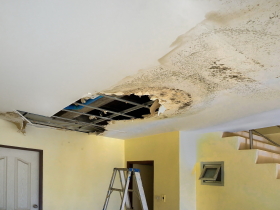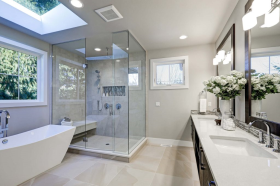When building or renovating a bathroom, waterproofing it properly should be a top priority. Without adequate waterproofing, the owner should expect a multitude of problems, from dampness and mould to more severe flooding and consequential damage. With this in mind, Howard Ball, Managing Director from CCL Wetrooms explains how to go about waterproofing a bathroom, as well as the legal considerations to be aware of.

Poor and ineffective waterproofing in a bathroom is the most common reason for leaks. In a bathroom, to avoid problems, it’s a good idea to fully waterproof – or ‘tank’ – anywhere that might come into contact with water. Usually, this will be anywhere that you’re considering tiling. There are two main products to be aware of when it comes to waterproofing a bathroom: tanking membrane and flexible wall membrane.
Tanking membrane
The simplest way to guarantee that a wet area is properly waterproofed is to put a tanking membrane beneath the tiles. This could be simply the area surrounding the bath and shower, and the tiles behind the sink, or the entire bathroom or wetroom. Either way, tanking membrane can be purchased in large tiles or rolls, which can usually be placed into position easily, thanks to its self-adhesive backing.
Flexible wall membrane
Another useful product is flexible wall membrane, which is a soft, acrylic paste. This can be manipulated into more difficult areas such as the corners where the walls and floor meet, or around windows. This paste is 100 percent waterproof, and is ideal for use below stone, ceramic, and porcelain tiles – much like the tanking membrane.
When it comes to waterproofing bathrooms, these two materials will be your two best friends. While splash-safe paint, water-resistant grout, and other similar products are advantageous, it’s the surfaces behind what you see that matter the most. Without adequate membrane, water damage is likely to occur. And, what’s more, it will probably go unnoticed for a considerable period of time, which means the problem will worsen without you realising. Make sure you put thorough waterproofing in place from the start, to avoid issues in the future.
Why proper waterproofing is vital

Without proper waterproofing, a new or renovated bathroom is likely to present some severely damaging problems. What starts as a minor drip will eventually become a substantial leak, potentially causing damage to the floor below and surrounding rooms.
According to data from insurance company Zurich, regarding their social housing claims, bathroom leaks are responsible for 37 percent of water damage claims relating to slow leaks. While this information only deals with a specific group of homes, it does illustrate the fact that bathrooms are the problem area when it comes to household leaks. Knowing this, properly waterproofing a bathroom or wetroom should be a priority for anyone installing one.
The costs associated with bathroom leaks can be substantial. From the initial plumber call out, to replacing damaged furniture – or even walls and flooring – the costs quickly add up. Tap Warehouse estimates that a leak from a bathroom that damages the ceiling below can cost up to £2,000 to repair.
Of course, it’s almost impossible to put a finite price on a bathroom leaking, but consider the following:
- Plumber’s call out charges and ongoing labour fees
- Replacement pipes and fittings
- Replacement plasterboard
- New waterproof membrane
- New furniture
- New appliances
- New flooring
Even though some of these costs may be absorbed by an insurance company, if appropriate cover is in place, remember that these claims will still involve an excess fee.
Thankfully bathroom and wetroom nightmares like these can be avoided, if the right waterproofing is put in place at the start of a bathroom installation project.
Waterproofing law and regulations

A few years ago, the British Standards Institute released new codes of practice for BS-5385-1, clause 6.1.1.3, regarding wall and floor tiling tanking.
The tiling regulations stipulate that when tiling in wet areas, all substrates must be waterproofed with a suitable tanking membrane system before tiling is carried out. This is to make sure that the substrate beneath the wet area is fully protected. In the past, materials used below tiling in wet areas were often vulnerable to moisture, such as plasterboard. So, the new changes to the regulations were put in place to ensure that there is better protection.
Another regulation states that: “the use of sheets or boards that are subject to movement from changes in moisture content should be avoided”. This covers materials including plywood, which is known to be susceptible to water infiltration.
Previous to this, the British Standard Institute had already stated that waterproofing membranes must be used in commercial settings, however the changes now apply to domestic properties too. This means that anyone looking to install a new bathroom or wetroom, in any kind of property, needs to make sure they are fully compliant with these regulations. They should be considered early on in the planning stages.
Proper waterproofing is necessary not only to protect your home and your belongings, but also for legal reasons. While it’s unlikely that any legal bodies will come to inspect a bathroom that has been fit in a privately owned home, there are other implications that non-compliance with the British Standards Institute may have. There may be issues should you ever need to make an insurance claim, if you cannot show that adequate waterproofing membrane has been used. There could also be problems if you ever want to sell your house. Prospective buyers may want to see evidence of waterproofing, or this could come up at the point of surveying before a mortgage is confirmed. Avoid all unnecessary issues by ensuring that you have reliable waterproofing in place at the point of installation.
More information
For more details, information and advice about successful bathroom waterproofing and wetrooms, please visit www.ccl-wetrooms.co.uk